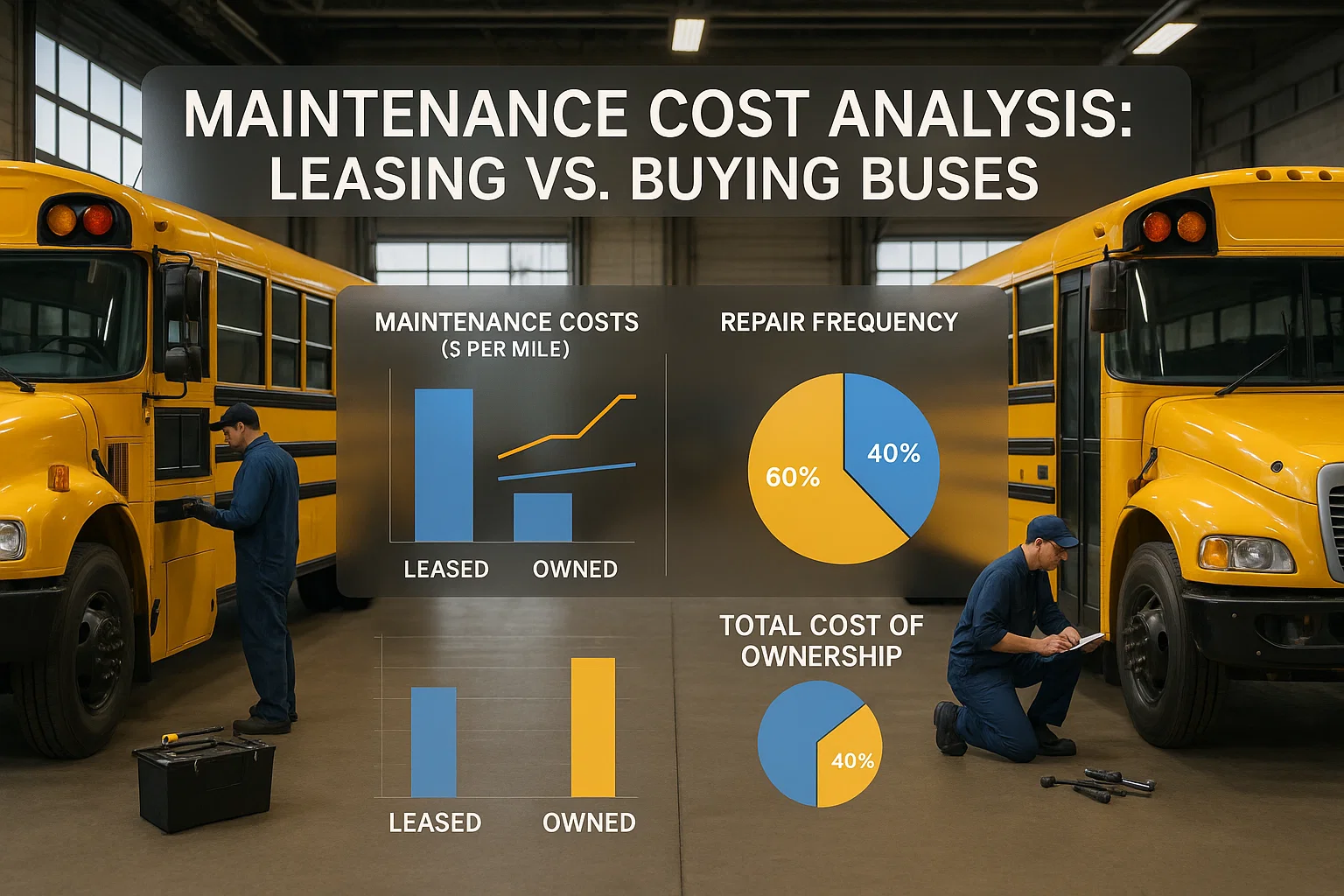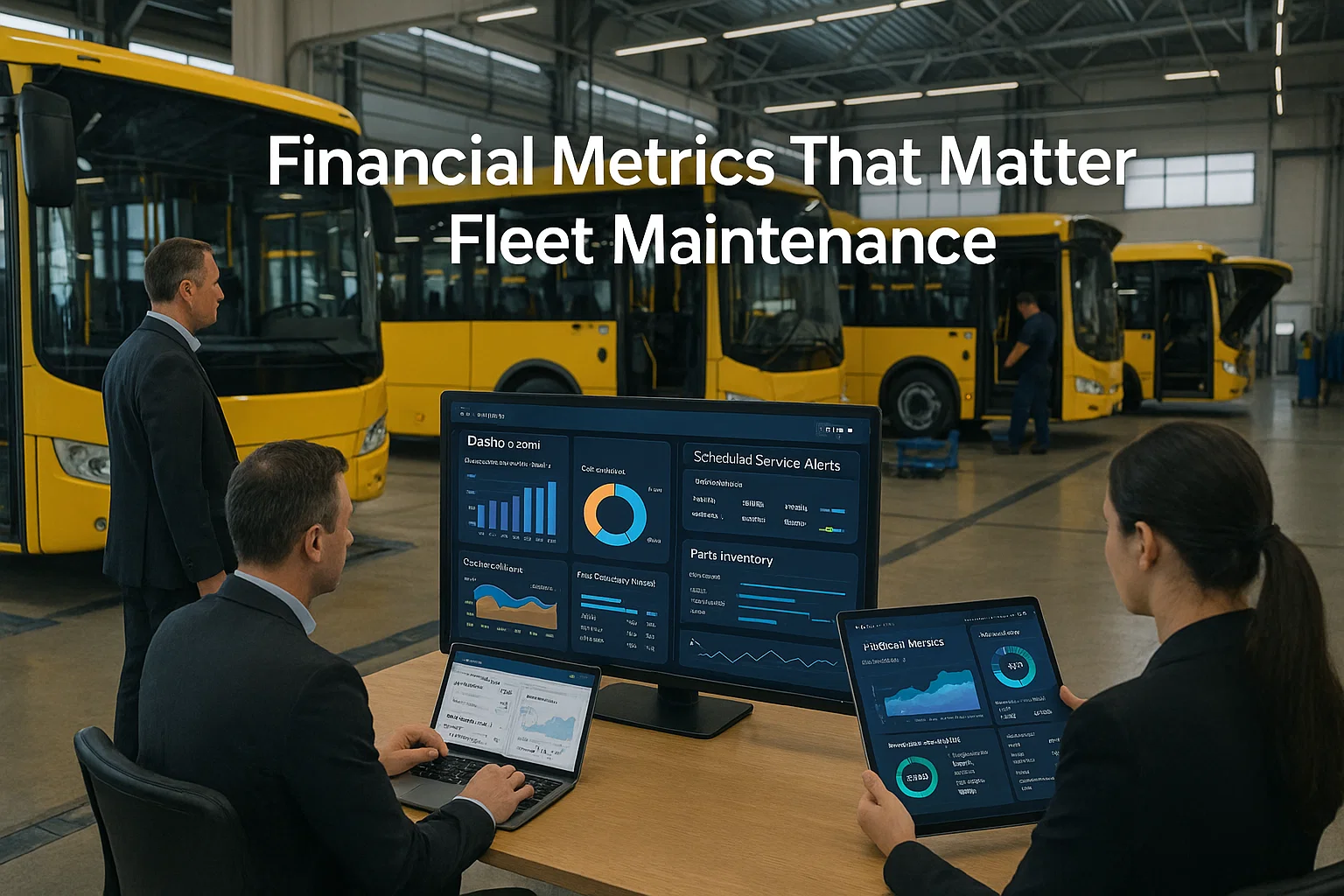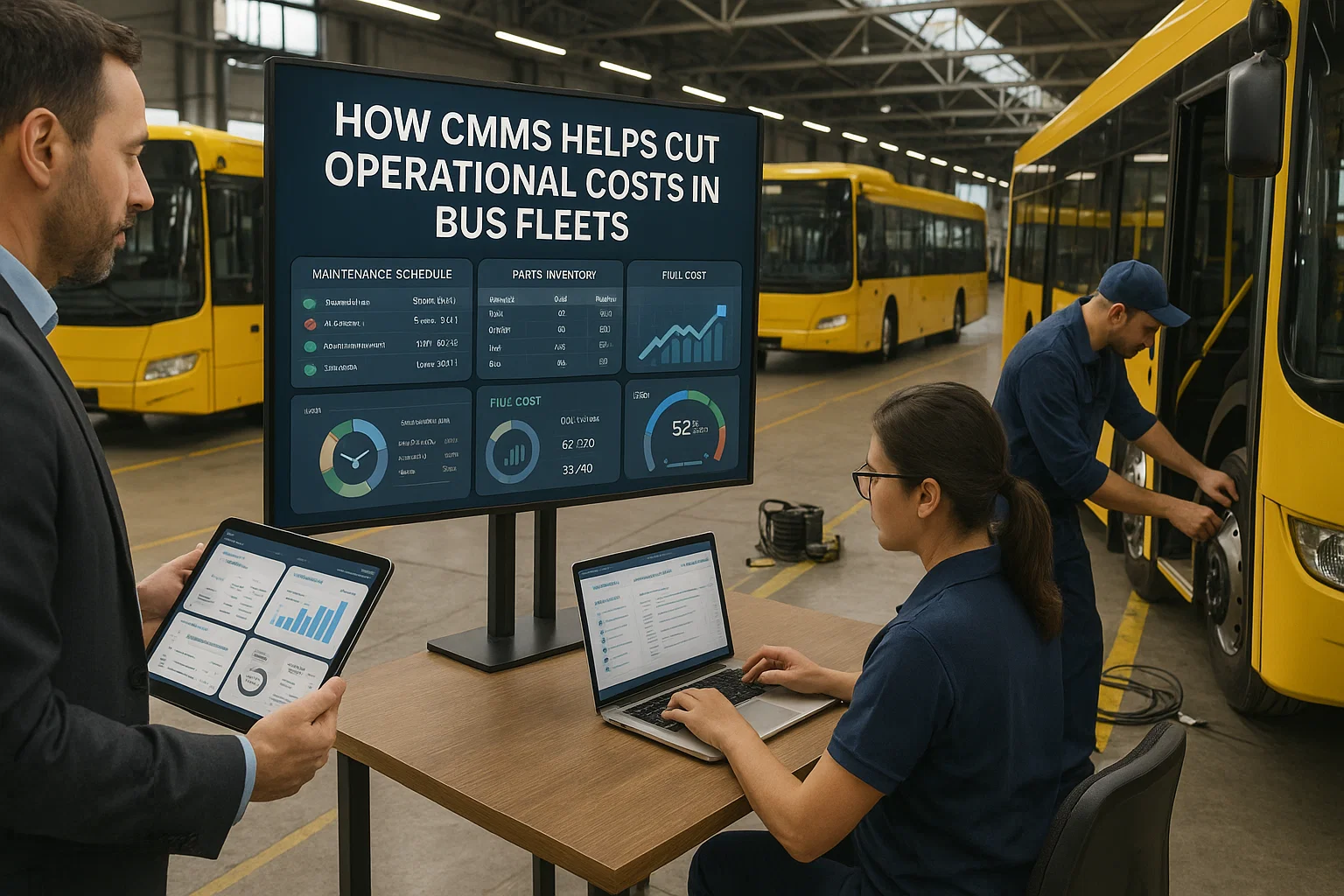The US bus fleet industry stands at a pivotal transformation point where automation isn't just an advantage—it's a necessity for survival. Modern Bus CMMS platforms are revolutionizing how fleet operators manage daily operations, from automated scheduling to predictive maintenance workflows that eliminate costly downtime.
Fleet automation through Computerized Maintenance Management Systems delivers immediate, measurable results. Organizations implementing Bus CMMS automation report average efficiency gains of 35-45%, with some achieving up to 60% reduction in manual administrative tasks. These improvements translate directly to bottom-line savings and enhanced service reliability.
This comprehensive guide explores proven automation strategies that transform fleet operations from reactive to proactive, examining real-world implementations across US bus fleets. Discover how intelligent automation creates competitive advantages while reducing operational costs and improving passenger satisfaction. Get started today to begin your automation journey.
Foundation of Fleet Automation Excellence
Building an automated fleet operation requires strategic integration of technology, processes, and people. Bus CMMS serves as the automation backbone, orchestrating complex workflows that previously required manual intervention at every step.
Core Automation Components
Successful fleet automation encompasses vehicle tracking systems, maintenance scheduling algorithms, driver management platforms, and passenger communication channels. These elements work synergistically through Bus CMMS to create self-managing operational ecosystems that adapt to changing conditions in real-time.
Advanced automation leverages artificial intelligence and machine learning to continuously improve processes. Pattern recognition algorithms identify optimization opportunities, while predictive models anticipate issues before they impact operations. This proactive approach reduces emergency interventions by up to 70%.
Integration Architecture
Seamless data flow between systems eliminates information silos that traditionally hamper efficiency. Bus CMMS platforms aggregate inputs from GPS trackers, diagnostic sensors, fuel monitors, and passenger counting systems, creating comprehensive operational intelligence that drives automated decision-making.
Ready to Eliminate Manual Processes?
See how Bus CMMS automation can transform your fleet operations in just 30 days
Getting Started Book a DemoCritical Automation Opportunities
High-Impact Automation Areas
- Preventive Maintenance Scheduling: Automated PM generation based on mileage, engine hours, and calendar intervals eliminates missed services
- Work Order Management: Intelligent routing of repair requests to qualified technicians with automatic parts reservation
- Inventory Replenishment: Predictive ordering systems that maintain optimal stock levels without manual intervention
- Compliance Tracking: Automated DOT reporting and inspection scheduling ensures regulatory adherence
- Driver Assignment: Smart matching of drivers to vehicles based on qualifications, hours of service, and route familiarity
Each automation opportunity represents significant time savings and error reduction. Bus CMMS platforms enable rapid deployment of these automations, with most organizations seeing immediate improvements within the first 30 days of implementation.
Automation Impact Metrics
Quantifying automation benefits helps justify investment and track progress. Key performance indicators include processing time reduction, error rate decrease, and resource utilization improvement. Fleet operators typically observe 40-50% reduction in administrative overhead after implementing comprehensive automation workflows.
Intelligent Maintenance Automation
Maintenance automation through Bus CMMS transforms reactive repair cycles into predictive maintenance strategies that maximize vehicle availability while minimizing costs. Advanced algorithms analyze vehicle data to optimize maintenance timing and resource allocation.
Automated Maintenance Workflows
Predictive Failure Analysis
Machine learning models analyze sensor data, maintenance history, and operational patterns to predict component failures before they occur, triggering preemptive maintenance actions.
Dynamic Scheduling Optimization
Automated schedulers balance maintenance requirements with operational demands, finding optimal service windows that minimize fleet disruption while ensuring compliance.
Resource Allocation Intelligence
Smart algorithms assign technicians, bay space, and tools based on skill matching, availability, and job priority, eliminating scheduling conflicts and bottlenecks.
These automated systems operate continuously, processing thousands of data points to optimize maintenance operations. Organizations report 35% reduction in maintenance costs and 45% improvement in vehicle availability after implementing automated maintenance systems.
Data-Driven Automation Intelligence
Leveraging big data analytics, Bus CMMS platforms transform raw operational data into actionable automation rules that continuously improve fleet performance. Real-time analytics dashboards provide visibility into automation effectiveness and optimization opportunities.
Automation Performance Metrics
- Process Completion Time: Track time savings achieved through automation versus manual processes
- Error Reduction Rate: Measure accuracy improvements in automated versus manual workflows
- Resource Utilization: Monitor efficiency gains in labor, equipment, and facility usage
- Cost per Transaction: Calculate cost reductions achieved through process automation
- Service Level Achievement: Assess improvement in meeting operational targets and SLAs
Advanced analytics enable continuous refinement of automation rules. Machine learning algorithms identify patterns and anomalies, suggesting process improvements that further enhance efficiency. This creates a virtuous cycle of continuous improvement.
Workflow Automation Strategies
Successful workflow automation requires strategic planning and phased implementation. Bus CMMS platforms provide flexible automation frameworks that adapt to unique operational requirements while maintaining standardization benefits.
Implementation Methodology
Begin with high-volume, repetitive processes that consume significant resources. Document current workflows, identify automation opportunities, and implement changes incrementally. This approach minimizes disruption while building organizational confidence in automation benefits.
Priority automation targets include inspection scheduling, parts ordering, timesheet processing, and report generation. Each automated workflow frees staff to focus on value-added activities that require human judgment and creativity.
Change Management Excellence
Successful automation requires organizational buy-in and cultural adaptation. Provide comprehensive training, communicate benefits clearly, and celebrate early wins. Bus CMMS platforms include built-in training resources and support systems that facilitate smooth transitions to automated operations.
Transform Your Fleet with Smart Automation
Join hundreds of fleet operators achieving 40% efficiency gains through Bus CMMS automation
Getting Started Book a DemoReal-Time Operations Automation
Live Operational Automations
- Dynamic Route Optimization: Continuous route adjustments based on traffic, weather, and passenger demand
- Automatic Driver Dispatch: Intelligent assignment of drivers to routes based on qualifications and availability
- Fuel Management Automation: Predictive fueling schedules that optimize costs and minimize downtime
- Passenger Communication: Automated updates on service changes, delays, and arrival times
Real-time automation through Bus CMMS enables instantaneous response to changing conditions. This agility improves service reliability while reducing operational stress on dispatch and management teams.
Advanced event processing engines monitor multiple data streams simultaneously, triggering appropriate responses based on predefined rules and machine learning insights. This creates resilient operations that adapt automatically to disruptions.
Compliance and Reporting Automation
Regulatory compliance represents a significant administrative burden for US bus fleets. Bus CMMS automation eliminates manual compliance tracking, ensuring adherence to DOT regulations while reducing administrative overhead by up to 60%.
Automated Compliance Features
Inspection Management
Automated scheduling and tracking of required inspections with digital documentation and automatic regulatory reporting.
Driver Qualification Tracking
Continuous monitoring of driver certifications, medical cards, and training requirements with automated renewal alerts.
Hours of Service Monitoring
Real-time HOS tracking with automatic alerts for approaching limits and integrated electronic logging capabilities.
Automated compliance systems eliminate violations caused by human oversight. Digital record keeping ensures audit readiness while reducing storage requirements and retrieval time. Organizations report 90% reduction in compliance-related citations after implementing automated tracking systems.
Mobile Automation Capabilities
Extending automation to mobile devices empowers field personnel with real-time capabilities. Bus CMMS mobile applications enable automated workflows anywhere, eliminating delays caused by geographic separation from dispatch centers.
Mobile Automation Features
- Digital Inspections: Automated pre-trip and post-trip inspections with photo documentation and instant defect reporting
- Work Order Completion: Mobile work order management with automatic parts usage tracking and labor recording
- GPS-Based Automation: Location-triggered workflows such as automatic status updates and geofence-based notifications
- Offline Synchronization: Continued automation functionality without connectivity, with automatic sync when connection restored
Mobile automation extends efficiency gains throughout the organization. Drivers complete digital inspections 50% faster than paper-based processes, while maintenance technicians reduce documentation time by 40% through mobile work order automation.
Integration with IoT and Telematics
Internet of Things (IoT) sensors and telematics systems provide rich data streams that fuel intelligent automation. Bus CMMS platforms integrate seamlessly with these technologies, creating comprehensive automation ecosystems.
Sensor-Driven Automation
Modern buses equipped with diagnostic sensors continuously transmit operational data. Engine temperature, oil pressure, brake wear, and hundreds of other parameters feed automated decision systems that optimize performance and prevent failures.
Telematics integration enables location-based automation, route optimization, and driver behavior monitoring. These systems work together through Bus CMMS to create intelligent fleets that largely manage themselves, requiring human intervention only for exceptions and strategic decisions.
Predictive Analytics Integration
Machine learning models analyze historical and real-time data to predict future events and optimize operations. These predictions trigger automated actions such as preventive maintenance scheduling, parts ordering, and resource allocation, creating proactive management systems that anticipate and prevent problems.
Frequently Asked Questions
How quickly can Bus CMMS automation show measurable efficiency improvements?
Bus CMMS automation delivers immediate benefits, with most fleets seeing measurable improvements within the first 30 days. Initial gains come from automated scheduling and work order management, typically reducing administrative time by 25-30% immediately. Within 90 days, as staff become proficient and more processes are automated, efficiency gains often reach 40-45%. The platform's intuitive design means minimal training is required, and built-in templates for common workflows enable rapid deployment. Real-world implementations show that automated preventive maintenance scheduling alone saves 3-4 hours daily for fleet managers, while digital inspections reduce driver paperwork time by 50%. These time savings compound as more automation features are activated, creating exponential efficiency improvements over the first year of implementation.
What specific cost savings can US bus fleets expect from CMMS automation?
US bus fleets implementing Bus CMMS automation typically achieve 20-35% reduction in total operational costs within the first year. Specific savings include: labor cost reduction of $50,000-$150,000 annually through eliminated manual processes, 15-25% decrease in maintenance costs through predictive scheduling, 10-20% fuel savings via optimized routing, and 30-40% reduction in inventory carrying costs through automated parts management. Compliance automation prevents costly violations, saving $10,000-$50,000 in potential fines. The platform's comprehensive reporting also identifies hidden inefficiencies, often uncovering additional savings opportunities worth 5-10% of operational budget. Most fleets achieve full ROI within 6-9 months, with ongoing annual savings that grow as automation capabilities expand and optimize over time.
How does Bus CMMS automation handle complex fleet operations with multiple locations?
Bus CMMS excels at managing multi-location fleet operations through centralized automation with localized flexibility. The platform's cloud-based architecture enables real-time synchronization across all locations while allowing site-specific customization of workflows and rules. Automated resource sharing optimizes parts inventory and technician allocation across facilities, reducing redundancy and improving utilization. Centralized reporting provides enterprise-wide visibility while maintaining granular control at each location. The system automatically handles inter-facility transfers, cross-location maintenance scheduling, and consolidated compliance reporting. Multi-site fleets report 45% improvement in resource utilization and 30% reduction in inter-location communication delays. The platform scales seamlessly from single-depot operations to nationwide networks, maintaining consistent automation benefits regardless of geographic complexity.
Experience the Power of Fleet Automation
Discover why leading US bus fleets choose Bus CMMS for operational excellence
Getting Started Book a DemoAchieving Peak Efficiency Through Automation
Fleet automation represents the most significant opportunity for operational improvement in the US bus industry today. Bus CMMS platforms provide comprehensive automation capabilities that transform every aspect of fleet operations, from maintenance management to regulatory compliance.
Success in automation requires strategic planning, phased implementation, and organizational commitment. However, the benefits—including 40% efficiency gains, 30% cost reductions, and dramatic improvements in service reliability—justify the investment and effort required.
As competition intensifies and passenger expectations rise, automation becomes essential for sustainable fleet operations. Organizations that embrace comprehensive automation today position themselves for long-term success in an increasingly demanding market.
Ready to Automate Your Fleet Operations?
Join the automation revolution and discover how Bus CMMS can transform your fleet efficiency.








